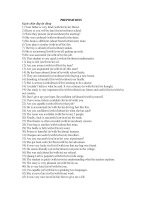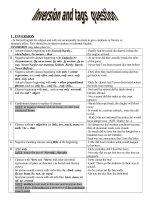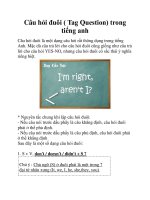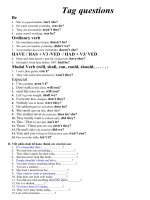tag question 1
Bạn đang xem bản rút gọn của tài liệu. Xem và tải ngay bản đầy đủ của tài liệu tại đây (69.83 KB, 13 trang )
<span class='text_page_counter'>(1)</span><div class='page_container' data-page=1>
Using Tag Questions
Using Tag Questions
By Liz Moya
</div>
<span class='text_page_counter'>(2)</span><div class='page_container' data-page=2>
What is a
What is a
tag question
<sub>tag question</sub>
?
<sub>?</sub>
A tag question is a sentence with a
A tag question is a sentence with a
question phrase connected at the end.
question phrase connected at the end.
Example:
Example:
It’s windy today, isn’t it?
It’s windy today, isn’t it?
</div>
<span class='text_page_counter'>(3)</span><div class='page_container' data-page=3>
Tag questions have two purposes:
Tag questions have two purposes:
1.
1.
To clarify information
<sub>To clarify information</sub>
(the speaker expects an answer)
(the speaker expects an answer)
Example:
Example:
We have a test tomorrow, don’t we?
We have a test tomorrow, don’t we?
Mr. Smith is coming to the meeting, isn’t he?
Mr. Smith is coming to the meeting, isn’t he?
I’m permitted to park here, aren’t I?
</div>
<span class='text_page_counter'>(4)</span><div class='page_container' data-page=4>
Tag questions have two purposes:
Tag questions have two purposes:
2.
2.
To agree with someone
<sub>To agree with someone</sub>
(the speaker does
(the speaker does
not expect
not expect
an answer)
an answer)
Example:
Example:
You’re falling asleep, aren’t you?
You’re falling asleep, aren’t you?
The party was a lot of fun, wasn’t it?
The party was a lot of fun, wasn’t it?
I didn’t win the lottery, did I?
</div>
<span class='text_page_counter'>(5)</span><div class='page_container' data-page=5>
Forming Tag Questions
Forming Tag Questions
(6 easy steps)
(6 easy steps)
Step 1:
Step 1:
Identify the verb in the sentence.
Identify the verb in the sentence.
Sergio likes to eat at buffets, ______ ______?
Sergio likes to eat at buffets, ______ ______?
</div>
<span class='text_page_counter'>(6)</span><div class='page_container' data-page=6>
Forming Tag Questions
Forming Tag Questions
(6 easy steps)
(6 easy steps)
Step 2:
Step 2:
Identify the type of verb.
Identify the type of verb.
(Is it the verb “to be”, an auxiliary verb, or the main
(Is it the verb “to be”, an auxiliary verb, or the main
verb?)
verb?)
Sergio likes to eat at buffets, ______ ______?
Sergio likes to eat at buffets, ______ ______?
</div>
<span class='text_page_counter'>(7)</span><div class='page_container' data-page=7>
Forming Tag Questions
Forming Tag Questions
(6 easy steps)
(6 easy steps)
Step 3:
Step 3:
Identify the tense of verb.
Identify the tense of verb.
(Is it in present or past tense?)
(Is it in present or past tense?)
Sergio likes to eat at buffets, ______ ______?
Sergio likes to eat at buffets, ______ ______?
</div>
<span class='text_page_counter'>(8)</span><div class='page_container' data-page=8>
Forming Tag Questions
Forming Tag Questions
(6 easy steps)
(6 easy steps)
Step 4:
Step 4:
If in
If in
present tense
present tense
, determine if
, determine if
1st
1st
or
or
3rd
3rd
person. If in
person. If in
past tense
past tense
, use
, use
auxiliary
auxiliary
“to be”
“to be”
or
or
“do” in past
“do” in past
.
.
Sergio likes to eat at buffets ,
Sergio likes to eat at buffets ,
_ _
_ _
______?
______?
Use the auxiliary verb
Use the auxiliary verb
“does”
“does”
.
.
Third person
</div>
<span class='text_page_counter'>(9)</span><div class='page_container' data-page=9>
Forming Tag Questions
Forming Tag Questions
(6 easy steps)
(6 easy steps)
Step 5:
Step 5:
Is the verb affirmative or negative?
Is the verb affirmative or negative?
Sergio likes to eat at buffets, __________?
Sergio likes to eat at buffets, __________?
Write in the opposite.
Write in the opposite.
Affirmative
</div>
<span class='text_page_counter'>(10)</span><div class='page_container' data-page=10>
Forming Tag Questions
Forming Tag Questions
(6 easy steps)
(6 easy steps)
Step 6:
Step 6:
Add the pronoun at the end.
Add the pronoun at the end.
Sergio likes to eat at buffets,
Sergio likes to eat at buffets,
doesn’t
doesn’t
?
?
Noun
</div>
<span class='text_page_counter'>(11)</span><div class='page_container' data-page=11>
Overview
Overview
Step 1:
Step 1:
Identify the verb in the sentence.
Identify the verb in the sentence.
Step 2:
Step 2:
Identify the type of verb.
Identify the type of verb.
Step 3:
Step 3:
Identify the tense.
Identify the tense.
Step 4:
Step 4:
If in present tense, determine if 1
If in present tense, determine if 1
ststor 3
or 3
rdrdperson. If in past tense, use auxiliary
<sub> person. If in past tense, use auxiliary </sub>
“to be” or “do” in past.
“to be” or “do” in past.
Step 5:
Step 5:
Affirmative or negative?
Affirmative or negative?
Step 6:
</div>
<span class='text_page_counter'>(12)</span><div class='page_container' data-page=12>
Let’s Practice
Let’s Practice
Lunch was delicious,
Lunch was delicious,
?
?
Spring break is next week, _________?
Spring break is next week, _________?
Class finished quickly, _________?
Class finished quickly, _________?
wasn’t it
</div>
<span class='text_page_counter'>(13)</span><div class='page_container' data-page=13>
1.
1. You’ve called the movers,<sub>You’ve called the movers,</sub>
2.
2. They’re coming tomorrow,They’re coming tomorrow,
3.
3. This isn’t going to be cheap,This isn’t going to be cheap,
4.
4. You haven’t finished packing,You haven’t finished packing,
5.
5. We don’t need any more boxes,We don’t need any more boxes,
6.
6. Pablo is going to help us,<sub>Pablo is going to help us,</sub>
7.
7. We can put some things in <sub>We can put some things in </sub>
storage,
storage,
8.
8. Jack isn’t buying our bookcases,Jack isn’t buying our bookcases,
9.
9. We need to disconnect the phone,We need to disconnect the phone,
10.
10. The movers aren’t packing the The movers aren’t packing the
books for us,
books for us,
11.
11. We can’t turn off the electricity yet, <sub>We can’t turn off the electricity yet, </sub>
a.
a. can we?<sub>can we?</sub>
b.
b. do we?do we?
c.
c. is he?is he?
d.
d. isn’t it?isn’t it?
e.
e. aren’t they?<sub>aren’t they?</sub>
f.
f. have you?<sub>have you?</sub>
g.
g. isn’t he?<sub>isn’t he?</sub>
h.
h. is it?is it?
i.
i. haven’t you?haven’t you?
j.
j. don’t we?don’t we?
k.
k. can’t we?can’t we?
l.
</div>
<!--links-->









